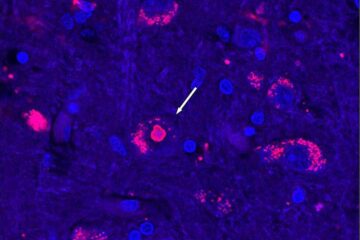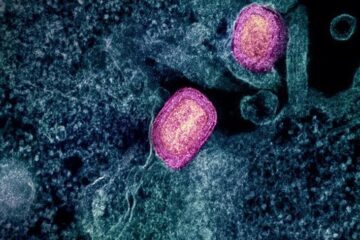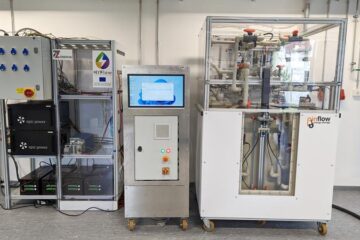Scientists discover ‘flipping’ layers in heterostructures to cause changes in their properties

Two different vdW heterostructures. The left consists of WS2 on top of WSe2, and the right consists of WSe2 on top of WS2. The two TMD layers are stacked on top of h-BN and Si/SiO2, which are substrates.
Credit: Institute for Basic Science
Dark excitons emerge exclusively at the top layer of bi-layered transition metal dichalcogenide heterostructures when the stacking order of the layers is changed.
Transition metal dichalcogenide (TMD) semiconductors are special materials that have long fascinated researchers with their unique properties. For one, they are flat, one-atom-thick two-dimensional (2D) materials similar to that of graphene. They are compounds that contain different combinations of the transition metal group (e.g., molybdenum, tungsten) and chalcogen elements (e.g., sulfur, selenium, tellurium).
What’s even more fascinating is that assembling different TMD layers into vertical stacks creates a new artificial material called a van der Waals (vdW) heterostructure. By incorporating different materials, it becomes possible to combine the properties of individual layers, producing new optoelectronic devices with tailor-made properties. This opens the door to exploring fundamental physics, such as interlayer excitons, twistronics, and many more.
However, until now, no scientists have studied whether changing the stacking order affects the spectroscopic properties of these heterostructures. For a long time, the lack of understanding of TMD heterostructures led to a questionable hypothesis that altering the stacking order of the layers does not affect their properties.
Stacking sequence-dependent dark exciton modulation. Left, schematic of WS2 (top)/WSe2 (bottom) hetero-bilayer and their corresponding core-spong PL. A new excitonic feature (red color peak) emerges at the hetero-bilayer region due to the downshifting of the Q-band (inset) only at the heterostructure. Right, opposite stacking of WSe2 (top)/WS2 (bottom) hetero-bilayer and their corresponding PL. The previous dark-exciton peak (red color peak) completely vanished, whereas another new excitonic feature (cyan color peak) emerged at the hetero-bilayer region due to the downshifting of the Q-band (inset) at the heterostructure. Credit: Institute for Basic Science
This was recently debunked by a team of researchers at the Center for Integrated Nanostructure Physics (CINAP), Institute for Basic Science (IBS) in South Korea. Led by Professor LEE Young Hee the group discovered that the sequential order of the layers in heterostructures affects the generation of “dark excitons” within the material. This finding suggested the added importance of considering stacking sequential order dependence of these materials for further use in real device applications.
Excitons represent an electron and a positively charged hole (a location where an electron is absent) bound together by electrostatic attraction in a solid material, typically a semiconductor crystal. Monolayer TMD semiconductors have a direct bandgap and exhibit optically accessible “bright excitons.” At the same time, there are also “dark excitons”, that are challenging to study due to their invisibility. However, the underlying mechanisms that give rise to these anomalies are not fully understood.
The IBS researchers observed a remarkable phenomenon: the emergence or disappearance of additional photoluminescence (PL) peaks based on different stacking sequences. This previously unreported effect has been confirmed to be reproducible across multiple heterostructures. The researchers attributed the origin of these additional peaks to the emergence of dark exciton exclusively located in the top layer of the heterostructure, which is further confirmed by scanning tunneling microscopy (STM). Researchers expect that this property can be utilized for optical power switches in solar panels.
Dr. Riya SEBAIT, the first author of the study said “Our experimental results clearly demonstrate stacking sequence-dependent anomalous properties, which could potentially pioneer a new field of study named ‘fliptronics.’ As we flip or invert the heterostructure, bands undergo a unique renormalization.”
A clean, residue-free interface is necessary to investigate stacking sequential dependent properties. This study represents a significant breakthrough as this was the first time. It was demonstrated that altering the stacking sequential order in the heterostructure can lead to changes in its physical properties.
Researchers attempted to explain this flip-induced phenomenon by looking into the microscopic many-particle model, which suggests that layer-dependent strain could be one possible solution to this puzzle. Assuming that the top layer becomes more strained compared to the bottom layer, the calculated data using the theoretical model shows good agreement with the experimental results. This suggests that this stacking sequence-dependent requires further study, not only for understanding the underlying physics but also for its real-device applications.
Furthermore, this study also facilitates the utilization of momentum-forbidden dark excitons, as due to the unique band renormalization at the heterostructure, it is possible to convert them into bright excitons.
Prof. Young Hee Lee, the main-corresponding author remarks that “This exceptional phenomenon of the emergence of dark excitons at the bilayer heterostructure will inspire other researchers to delve deeper into understanding and harnessing these extraordinary properties towards applications.”
This work was done in interdisciplinary collaborations with Prof. Ermin MALIC at Philipps-Universität Marburg, Germany, and research fellow SEOK Jun Yun from Oak Ridge Laboratory, USA.
Journal: Nature Communications
DOI: 10.1038/s41467-023-41047-6
Method of Research: Experimental study
Subject of Research: Not applicable
Article Title: Sequential order dependent dark-exciton modulation in bi-layered TMD heterostructure
Article Publication Date: 8-Sep-2023
Media Contact
William Suh
Institute for Basic Science
willisuh@ibs.re.kr
Office: 82-010-379-37830
All latest news from the category: Interdisciplinary Research
News and developments from the field of interdisciplinary research.
Among other topics, you can find stimulating reports and articles related to microsystems, emotions research, futures research and stratospheric research.
Newest articles

After 25 years, researchers uncover genetic cause of rare neurological disease
Some families call it a trial of faith. Others just call it a curse. The progressive neurological disease known as spinocerebellar ataxia 4 (SCA4) is a rare condition, but its…

Lower dose of mpox vaccine is safe
… and generates six-week antibody response equivalent to standard regimen. Study highlights need for defined markers of mpox immunity to inform public health use. A dose-sparing intradermal mpox vaccination regimen…

Efficient, sustainable and cost-effective hybrid energy storage system for modern power grids
EU project HyFlow: Over three years of research, the consortium of the EU project HyFlow has successfully developed a highly efficient, sustainable, and cost-effective hybrid energy storage system (HESS) that…





















